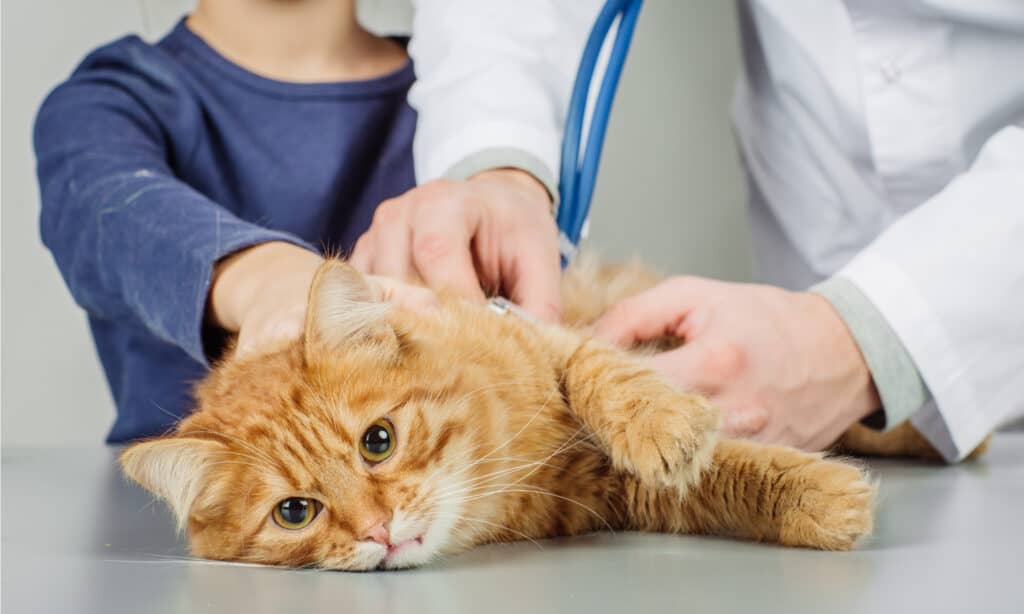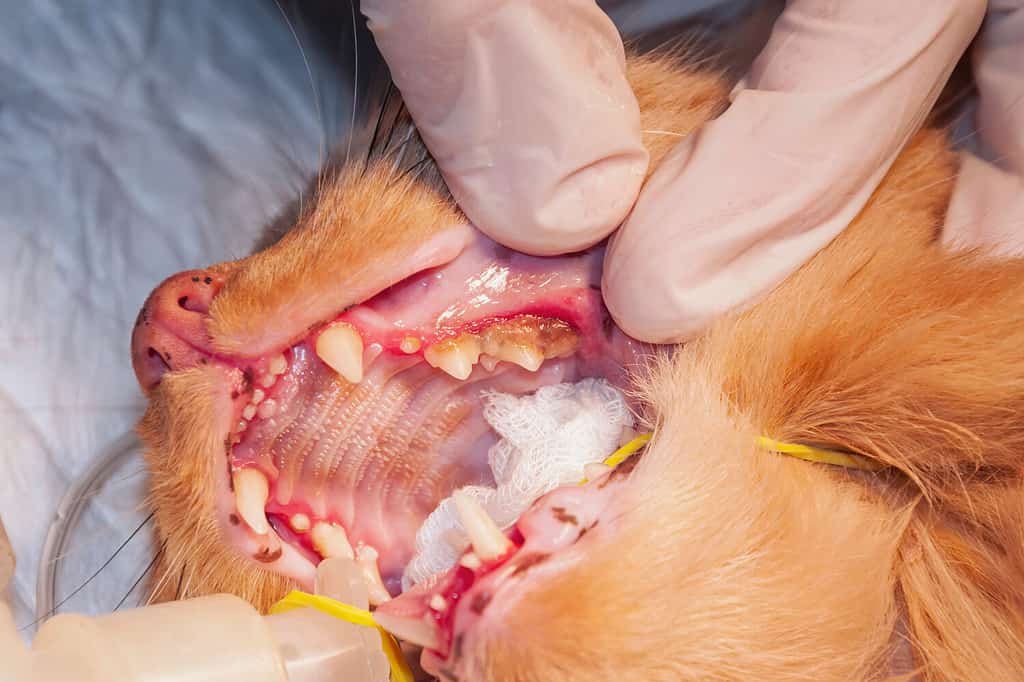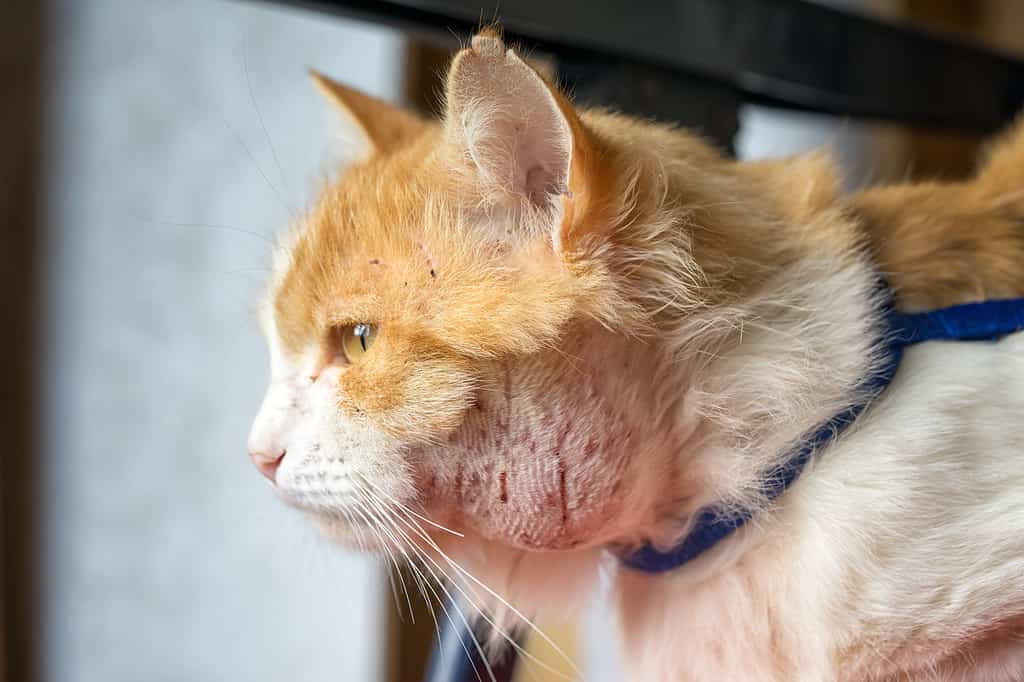
Only a veterinarian has the knowledge to determine if your cat needs clindamycin.
©PRESSLAB/Shutterstock.com
Clindamycin is a bitter-tasting antibiotic medication used by veterinarians to treat infections in both cats and dogs. Common uses include wounds, abscesses, skin infections, and dental disease. While some veterinarians use clindamycin off-label for birds, ferrets, and reptiles, this medication should never be used in horses, cows, sheep, goats, and other small mammals. That’s because it can cause fatal diarrhea in these species.
The FDA and Clindamycin
Off-label means using a medication in patients or diseases for which the FDA (Food and Drug Administration) has not approved. The FDA, of course, is limited to the United States, so other countries may use this medication differently.
The FDA published an article regarding the effectiveness of ClindaMed (a brand of clindamycin) in dogs and cats. They also included rats in the study. They discussed that clindamycin is readily absorbed through the gastrointestinal tracts of mammals. Furthermore, they also reported that it kills a number of aerobic and anaerobic bacteria. Aerobic bacteria require oxygen to live, while anaerobic bacteria do not. In fact, some anaerobic bacteria die when exposed to oxygen.
Warning
Just a quick reminder – giving medication of any kind to your pet requires a veterinarian’s advice and direction. This article does not replace veterinary advice. Failure to consult a veterinarian before giving medication to your cat could result in major side effects up to and including death.
Let’s check out the uses, side effects, dosage, and more of clindamycin in cats!
What is Clindamycin Used for in Cats?
Clindamycin treats a variety of conditions in cats. This medication is considered to be relatively safe to use in cats of all ages. However, young kittens may experience more side effects. Let’s learn about the most common applications of this antibiotic below!

More than half of all cats over the age of 3 years have some form of dental disease.
©mojahata/Shutterstock.com
Dental Disease
Dental disease presents in more than half of all cats over the age of three years. Really, it is one of the most common illnesses among cats worldwide. Properly called periodontal disease, gingivitis (inflammation of the gums), tartar buildup, and tooth root resorption lead to more serious problems. Feline dental disease results in the loss of teeth if not treated.
Usually, a dental cleaning can help restore cat teeth and relieve gingivitis. However, sometimes infection builds around the root of a tooth leading to an abscess. Cats with active abscesses cannot undergo dental surgery as the risk of sepsis (an infection that moves into the bloodstream) is extremely high in such cases. Cats with this condition often must take clindamycin for 14 days prior to their dental cleaning.
Signs your cat has periodontal disease include bad breath, inflammation around the gums, discolored teeth, and drooling. Your cat may also refuse to eat hard food if their teeth are causing them pain.
Abscess
Cats, especially those that venture outdoors, are extremely prone to developing abscesses. That’s because they tend to get in fights with other cats, dogs, or wild creatures (like raccoons and opossums). An abscess is a pus-filled pocket that forms around a wound or injury.
The nature of cats predisposes them to develop abscesses. Their bodies readily lock away bacteria and infection in pockets that fill with pus. Cats are designed to show as little pain as possible since they are both predators and prey. Oftentimes, it’s hard to tell when a cat is sick before they get to a point where they become very lethargic (weak and having little energy to move). That leads to large, deep abscesses going untreated for long periods of time.
Sometimes, abscesses rupture on their own. Other times, they need to be lanced (the medical term for cutting open an abscess). Regardless of the method that opens the abscess, the resulting wound needs flushed with an antiseptic solution, and the cat should take antibiotics. Clindamycin is commonly prescribed for the treatment of abscesses in cats.
Interestingly, the placement of an abscess in a cat indicates what type of fight occurred. An abscess on the face, foreleg, or chest tells you the cat likely initiated the fight and intended to win. An abscess forming on the rear leg, tail, or flank suggests the cat fled from the fight. The best way to prevent abscesses in your cat is to keep them inside!

Abscesses in cats usually occur as the result of a bite wound from another cat.
©Elen11/iStock via Getty Images
Side Effects of Clindamycin in Cats

Drooling can be a sign of nausea or tasting something gross in cats.
©Schearbl/iStock via Getty Images
While side effects of clindamycin are uncommon in cats, it’s important to be aware of them. Remember, if you think your cat is having a side effect from any medication, the best thing to do is call your veterinarian right away! Some side effects can be serious or even life-threatening.
Possible side effects include:
- Vomiting
- Nausea
- Drooling/foaming at the mouth – due to the bitter taste and/or nausea
- Diarrhea – with or without blood
- Stomach ulcers
- Refusal to eat – Cats can suffer from hepatic lipidosis (fatty liver syndrome) after only 48 hours without food.
- Lethargy/lack of energy
- Injury of the esophagus (the tube in the throat that passes food, water, etc. into the stomach)
- Liver irritation
- Kidney damage
- Gallbladder disease
When Should Cats Not Take Clindamycin?

Mothers nursing kittens should not take clindamycin as it can cause diarrhea in the kittens.
©A-Z-Animals.com/Rachael Monson / Nemera Bengals
Dr. Shelly Wyatt, a licensed Doctor of Veterinarian Medicine at Northwood Hills Animal Hospital, told AZ Animals, “Clindamycin should be used with caution in pregnant or nursing cats and those with known kidney or liver disease. Because the drug is processed through the kidney and liver, additional damage could occur. Young kittens are more susceptible to diarrhea related to clindamycin than older cats, as well.” Diarrhea can be harmful for kittens because it causes dehydration.
One study showed that cats who were given a combination of probiotics and prebiotics (symbiotics) had fewer reactions to the medication than those who did not take them.
Conditions That Prevent Your Cat From Taking Clindamycin
A few conditions require extra caution when treating cats with clindamycin. They include:
- Pregnancy
- Nursing
- Liver Disease
- Kidney Disease
Medications Your Cat Cannot Take With Clindamycin
Some medications may increase the risk of side effects when given along with clindamycin in cats and vice versa. As always, tell your veterinarian any and all medications, supplements, vitamins, and herbal remedies your cat is taking. This way, they can determine if clindamycin is safe for your cat. We found no specific information regarding medications that absolutely should not be taken with clindamycin.
Dosage Chart for Clindamycin in Cats
Always follow your veterinarian’s instructions exactly and finish the prescribed course unless otherwise instructed, even if your cat appears to be feeling 100% better.
This chart is for informational purposes only. Do not give clindamycin to your cat without consulting a veterinarian. The typical dose range for clindamycin in cats is 2.5 mg per pound to 10 mg per pound. Dosing is usually every 12 hours but sometimes is reduced to every 24 hours. You should always give this medication with a full meal as it can cause stomach upset and nausea.
| Cat’s Weight in Pounds | Clindamycin Dosage | Cat Breeds Include |
|---|---|---|
| 0-5 | 2.5-50 mg per dose | Singapura, Bambino |
| 6-10 | 15-100 mg per dose | Siamese, Cornish Rex |
| 11-20 | 27.5-200 mg per dose | Bengal, Ragdoll |
| Over 20 | consult your vet | Maine Coon, Savannah |
Final Thoughts on Clindamycin for Cats
It goes without saying, but we’ll reiterate for emphasis – owners should never give a cat any medication without first discussing it with their veterinarian. Clindamycin remains one of the safest antibiotics to use in cats. The side effects are commonly mild, and overdose is rare. Clindamycin in cats treats many conditions, including dental infections and abscesses. Has your cat ever needed this medication?
The photo featured at the top of this post is © Lightspruch/Shutterstock.com
Thank you for reading! Have some feedback for us? Contact the AZ Animals editorial team.






